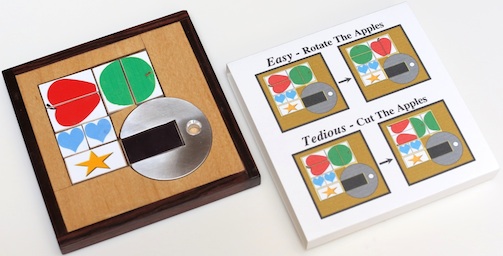
Designed by Minoru Abe circa 2000; this one made by J. A. Storer 2012.
(1/4" thick aluminum turntable and maple plywood with Kingwood trim, 4x4x1/2 inches)
Remove the black keeper. Easy shown on the left below is to rotate the fruit; it can be solved in 226 rectilinear moves if a single move may pass through the turntable independent of its initial orientation, 250 rectilinear moves if both entering and leaving the turntable starts a new move, and 280 rectilinear moves if repositioning the turntable requires an additional move. On the right, which we call Tedious, is to cut the fruit; it can be solved in 302, 334, or 374, moves respectively.
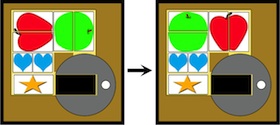 Easy |
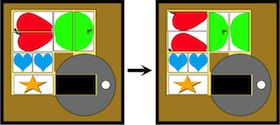 Easy |
These solutions never rotate the 1 2 pieces; below are key steps from the 302 rectilinear Tedious solution that can be viewed as two initial steps, followed by moving 1 2 from one side of the puzzle to the other a number of times to allow an exchange, followed by three final steps:
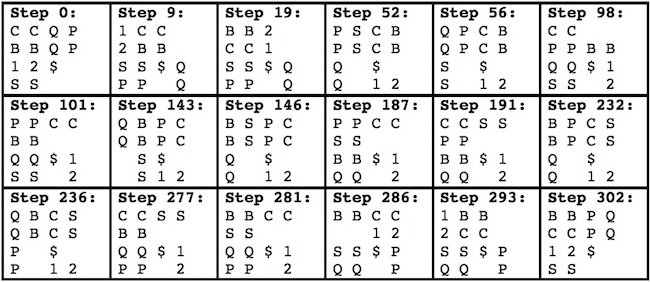
- From 1/4" thick maple plywood, cut the pieces.
- Make the piece graphics on a computer, print on glossy photo paper, cut them out, glue onto the pieces using a glue stick, and lightly sand to blend in the edges of the paper.
- Make the turntable piece; this one was made by roughing it out from 1/4" aluminum plate on a band saw, finishing on a lathe, drilling and beveling the hole, cutting the rectangle into it with a band saw, and then finishing the rectangle with some light sanding. Note that a hole was drilled and threaded in the center so that a screw could be inserted for the purpose of holding the turntable for turning on the lathe, and then this hole went away when the rectangle was cut.
- From 1/4" thick maple plywood, cut three rectangles to be significantly larger than the puzzle will be (e.g., 1" bigger on all sides); save rectangle 1 for the bottom of the puzzle. Cut rectangle 2 to be an L-shape for the left and top sides of the puzzle, but leaving it too thick and two long in both directions. Cut a hole in Rectangle 3 for the turntable and then cut it to be an oversize L with a partial circle positioned in the corner.
- Trim off the ends of rectangle 1 a little bit at a time until you get a nice fit for the pieces to move around when it is pushed together with rectangle 2 (use a miter saw to make clean ends so that the two seams will no show much).
- Using white glue, glue the L's onto the bottom piece, and let dry.
- Trim the puzzle to be square but still oversized with a band saw, and then using a table saw, trim to leave a 1/2" border around the puzzle area.
- From a dark wood cut 4 sticks that are 1/2" wide, 3/8" thick, and longer than the edges of the puzzle. Glue them to the edges of the puzzle in an overlapping pattern going around, leaving the excess ends sticking out:
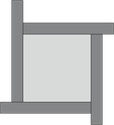
- After the sticks have dried, trim off the excess with a band saw. Then, on a table saw, make final passes on the edges to form a uniform 1/4" wide dark wood border.
- Print on light cardboard stock a cover to slide over the puzzle, cut and fold to fit the puzzle so that the ends overlay about 3/4" on the back side, and use a glue stick to join the ends (for a bigger puzzle join in two places to a second piece on the back).